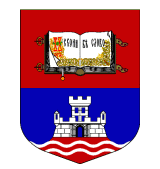In Serbia and western Balkans CMT is a pioneer in the field of plasmonics – investigation of complex metal-dielectric structures supporting surface plasmons polaritons, i.e. surface electromagnetic waves coupled with free carriers in conductor at an interface between a material with negative and positive dielectric permittivity. Plasmonic structures were proposed in Science journal as a building block merging electronics and photonics, i.e. incorporating positive properties of electronic circuits (their compact dimensions) and optical circuits (high operating frequencies). On the other hand, localization of electromagnetic field at the interface is convenient for applications in ultrasensitive sensors of chemical or biological analytes. Actually, papers were published in Nature journal showing that plasmonic sensors can reach single molecule sensitivity.
CMT research in the field of plasmonics is both theoretical and experimental and is dedicated towards the subwavelength plasmonic crystals, i.e. ordered metal-dielectric structures with submicrometer dimensions. The experiments are determined by available technology in the CMT and are mostly directed towards multilayer metal dielectrics and periodic 2D structures that can be fabricated by direct writing of photolithographic masks. Some of more complex experiments were performed in cooperation with EU research institutions.
Within our research in plasmonics, a part of our effort is dedicated to alternative plasmonic materials like transparent conductive oxides, i.e. indium tin oxide or aluminum-doped zinc oxide. Among theplasmonic structures fabricated in CMT are metal-dielectric filters based on silver and silica that cuts off visible and IR radiation and suppresses undesired wavelengths 4-6 orders of magnitude. Other investigated structures are "designer plasmon" 2D arrays with complex-shaped apertures with details at the deep subwavelength level. These arrays are obtained by superposition of primitive shapes and ensure the use of nonlocality effects for tailoring of spectral dependence. One of the topics of intestigation are complex 1D plasmonic crystals, like e.g. hyperbolic optical metamaterials.

